Maryland & Chesapeake Bay Fishing Report- August 17, 2023
Bluefish and Spanish mackerel are caught on the troll, large red drum hit soft plastics in the lower Bay, and bottom fishing yields sea bass, flounder and triggerfish from the reefs.
Tochterman’s Fishing Tackle Report — Baltimore, MD
The Tochterman’s Fishing Tackle Fishing Report is written by Tochterman’s team member, Kevin Trupia.
Striper fishing is still doing well at the Conowingo Dam. The early morning topwater bite and evening hours are producing the most fish. Stripers are still being caught at the Patapsco River and north to Pooles Island. Live-lining spot, jigging soft plastics, and topwater are three techniques worth utilizing.
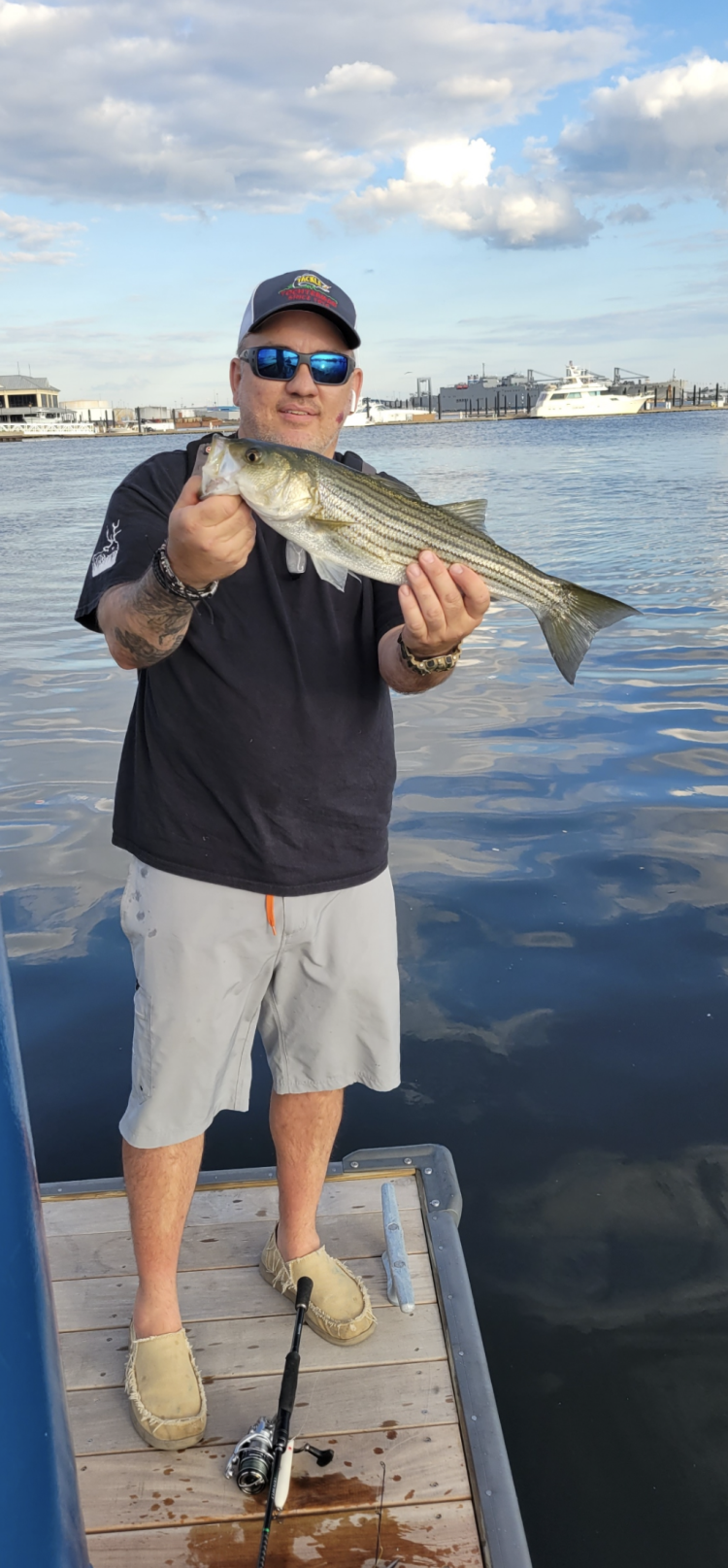
Not much has changed lately with the white perch and catfish bite. They can both be found all throughout the Bay and its tributaries. Small jigs and small spoons, along with live bait like lugworms, bloodworms and grass shrimp are the best baits for white perch, and cut bait and shrimp are best for the catfish.
Snakeheads are also a fun target for anglers in grassy areas with lots of cover from lily pads, with topwater frogs working best. Open water on edges of grass and area piers can also produce with spinners like a #4 Mepps, or weedless-rigged soft plastic paddletails.
The Tochterman’s Fishing Tackle Fishing Report is written by Tochterman’s team member, Kevin Trupia.
Maryland DNR Fishing Report
Maryland Fishing Report is written and compiled by Keith Lockwood, fisheries biologist with the Maryland Department of Natural Resources.
Maryland Department of Natural Resources’ biologists are looking to better understand the striped bass recreational fishery in the Chesapeake Bay and are asking for your help. Biologists have set up an online survey site where anglers can enter fishing data from a smartphone or computer. All you need to record is the length of the striped bass you catch and whether you kept or released them. On the department website, search for volunteer angler surveys to find the striped bass survey and others that may interest you.
Upper Chesapeake Bay
Anglers in the Conowingo Dam pool and lower Susquehanna River are enjoying fishing for striped bass in the early morning and evening. The dam is on an afternoon-evening power generation schedule so a refreshing surge of cool water flows through the dam pool and the lower river at these times. Popular choices for fishing them include casting topwater lures before sunrise and after sunset, and using jerkbaits, crankbaits, soft plastic jigs, and paddletails.
Striped bass fishing picked up right where it left off at the mouth of the Patapsco River. Anglers are using spot for live-lining with good success during the morning. There is also action at the Key Bridge and north to Pooles Island. Jigging is a good option along the channel edges and near the Key Bridge piers. Farther up the Patapsco near the commercial piers there is good topwater lure action at dawn. There has also been good striped bass fishing by live-lining and jigging at the Love Point rocks.
White perch can be found in all upper Bay tidal rivers and can be caught fishing with grass shrimp, pieces of bloodworm, peeler crab, or small minnows when fishing in deeper waters. During the early morning and late evening, casting roadrunner lures, small spinnerbaits, or jigs is a fun way to catch white perch.
Blue catfish provide plenty of fishing opportunities and can be found in the tidal rivers and the uppermost parts of the Bay. Fishing the bottom with fresh cut bait of menhaden is the most popular way to find them, and other bait options can work well also.
Middle Bay
Striped bass are being caught on the east side of the Bay Bridge at the 30-foot drop-off. The fish are holding tight to the bridge piers during a good running tide. Drifting with live spot, small white perch, or soft crab baits works well. The best action is during the early morning, and then slacks off as the sun rises in the sky; the late evening also provides good fishing.
Much of the better striped bass fishing in the middle Bay occurs early morning or late evening in the shallower waters along the Bay and tidal river shorelines. The rocks along Poplar Island and Thomas Point are also good places to cast topwater lures or paddletails. Speckled trout, bluefish, and puppy drum are also a welcome addition to the mix being caught.
Bluefish can be found throughout the middle Bay this week; along the edges of the shipping channel and the False Channel area, Spanish mackerel can be mixed in with them. The shipping channel edge from Buoy 83 south past the Sharps Island Light is a very good place to target Spanish mackerel this week. When trolling, a mix of bright-color Drone Spoons or gold Clark spoons behind No. 1 planers at 7-8 knots is the best way to target them.
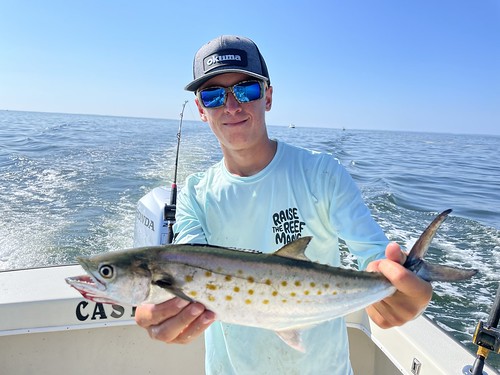
White perch continue to offer plenty of summer fun fishing off docks and piers and on the shorelines of the Bay and tidal rivers. Grass shrimp, pieces of bloodworm, peeler crab, or small minnows are great baits to use on a simple bottom rig when fishing deeper waters close to structure. During the early morning and late evening, casting roadrunners, beetle-spins, and small spinnerbaits near shoreline structure is a fun way to catch white perch on light tackle. Chartreuse and silver Clouser minnows cast on a 5-weight fly rod is another great way to enjoy the action.
Lower Bay
Anglers fishing for striped bass are finding them along the shorelines of the lower Bay and tidal rivers. This is an early morning or late evening affair for those casting topwater lures, jerkbaits, and paddletails. Speckled trout, bluefish, and puppy drum are also part of the mix, especially on the Eastern Shore. The main stem of the Potomac River remains closed to striped bass fishing until August 20, but anglers can fish the Maryland tributaries, such as the St. Marys River. Virginia waters do not open to striped bass fishing until October 4.
Bluefish can be found throughout the lower Bay and can be caught in a variety of ways. Most are being caught by trolling or by casting into breaking fish. Often the bluefish can be found mixed in with Spanish mackerel. If you are lucky, diving gulls can mark the way to breaking fish where bay anchovies are being pushed to the surface. Casting small but heavy and flashy metal jigs into the action and letting them sink a bit before retrieving is a great way to get into the bluefish and Spanish mackerel. Approach carefully from the upwind side of the action and quietly drift into casting range. A fast retrieve will catch the attention of the Spanish mackerel, and a slower retrieve will attract bluefish.
Large red drum continue to frequent the area around the Target Ship, the Mud Leads and the Middle Grounds. At times they can be found under breaking Spanish mackerel and bluefish, and other times slicks and churned-up water can indicate their presence. Jigging with large soft plastics or dropping soft crab baits will entice them for some exciting catch-and-release action.
Cobia can be found near Smith Point and near the Target Ship; there are not many to be found but it only takes one legal-sized cobia to make your day. Most anglers are chumming and fishing with live eels in the back of their chum slicks.
Atlantic Ocean and Coastal Bays
Surf anglers are catching a mix of kingfish and spot on bloodworms and artificial bloodworm baits. The best fishing is occurring during the early morning. Bluefish can be caught on finger mullet. At night large red drum continue to be caught and released, as are a mix of inshore sharks.
At the Ocean City Inlet, sheepshead are being caught on sand fleas near the jetties and the Route 50 Bridge piers. Bluefish and striped bass are being caught on soft plastic jigs and by drifting cut bait. In the back bay channels flounder fishing has been good during the top of the flood tide and the beginning of ebb.
Fishing for sea bass, triggerfish, and flounder continues to be good at the wreck and reef sites. At the canyons, a mix of bigeye and yellowfin tuna are being caught. Small dolphin are being caught near the lobster buoys and any floating debris. Blueline and golden tilefish are being caught at the canyon edges.
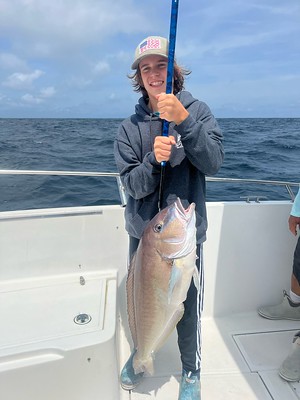
Freshwater Opportunities
To better facilitate fishing for invasive blue and flathead catfish, the Department of Natural Resources has instituted a regulation change regarding cut bait in non-tidal waters. Anglers will now be able to use cut bait of fish, such as bluegill sunfish, with no minimum size restrictions. There is a maximum of two pounds of cut bait allowed in an angler’s possession.
Freshwater anglers are enjoying the summertime passion of fishing quiet ponds, reservoirs, and tidal waters this week. Largemouth bass are usually the target for most anglers but a mix of chain pickerel, bluegill sunfish, and crappie can also be found.
Northern snakeheads are in various stages of spawning and protecting fry balls of their young. They can be found in the shallows in thick grass.
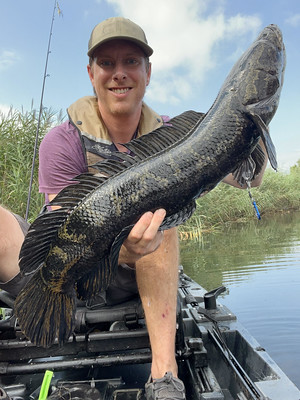
Casting buzzbaits, chatterbaits, and soft plastic frogs can often annoy snakeheads enough to strike. They are not feeding but will protect their young from perceived threats, so it may take more than one cast to get them to strike.
Maryland Fishing Report is written and compiled by Keith Lockwood, fisheries biologist with the Maryland Department of Natural Resources.
Angler’s Sport Center Fishing Report – Annapolis, MD
The Angler’s Sport Center fishing report is compiled and written by Anglers Team Member, A.J. Lewis.
Upper and Middle Bay
Live-lining spot at the mouth of the Patapsco River is netting anglers slot-sized striped bass! Areas like the Key Bridge, Conowingo Dam, and lower Susquehanna are also proving to be a popular place to get some slot-size bass! Anglers are finding the most success live-lining in the morning/evenings, however, jigging with soft plastics stickbaits or paddletails is also very effective.
Anglers are finding an abundance of live-line worthy spot in areas around Podickory Point and the western part of the Chesapeake Bay Bridge. The favored technique is jigging with Chesapeake sabiki rigs tipped with either bloodworms or artificial bait.
White perch are being found in every tidal river of the Upper and Middle Chesapeake Bay. Anglers are catching tons of white perch in shallow waters by casting spinners past structure such as logs, piers, or reefs. Jigging with bottom rigs or Chesapeake sabiki rigs near deeper water structure or drop offs will net you bigger white perch.
Bluefish and Spanish mackerel are being caught along the edges of the shipping channel. Anglers are having tons of luck using vibrant Drone spoons and Clark spoons under #1 or #2 planers.
South Bay
Bluefish and Spanish mackerel are being caught all throughout the Lower Bay area. Trolling is proving to be the best way to get good sized mackerel or bluefish.
Schools of redfish are roaming the South Bay area in numbers. Anglers are having huge success using 7-inch Bubblegum DieZel MinnowZ with a 1-ounce G-Eye Jigs HD jighead!
Cobia are being caught around Smith Point and the Target Ship. The favored bait and technique is drifting live eels in a chum slick, however, anglers are also having luck using the 7-inch Bubblegum DieZel MinnowZ. Redfish are also present in those areas so you may hook a drum or two while targeting cobia!
The mouth of the Potomac River is an excellent place to target multiple species. Anglers are finding lots of invasive blue catfish starting from the mouth, and all the way up the main stem of the river. Speckled trout are being caught all along the shoreline in the early morning hours using smaller paddletails.
Additional Info.
Striped bass are once again open for fishing in most parts of the Chesapeake Bay! They’ve returned to the 19- to 31-inch slot, with a limit of 1 per day, per angler.
The Angler’s Sport Center fishing report is compiled and written by Anglers Team Member, A.J. Lewis.
Reel Chesapeake Fishing Report – Annapolis, MD
The Reel Chesapeake Fishing Report is written and compiled by writer and media professional, James Houck. Find the full report here, at reelchesapeake.com.
Since last week, the middle Chesapeake has seen plenty of excellent opportunities to hit the water and catch fish. Calm winds coupled with high and generally strong tides coinciding at sunrise for most of the past 6 to 7 days did, indeed, create excellent conditions for topwater striper fishing at dawn. Cutlass fish also have been abundant in the middle bay, hitting jig/paddletail combos, as have decent specks and puppy drum, while cocktail bluefish and some Spanish mackerel are actively hitting flashy metals and Gotcha plugs. Sight fishing for northern snakehead remains prime, and tempting a variety of freshwater species—large and smallmouth bass, sunfish, and crappie—is still a manageable affair in abundant waters. Let’s dive in…
I’ll start in the Severn River because, per usual, it’s my home water and where I fish patterns firsthand. The topwater game for schoolie stripers has been hot. And I get a kick seeing boats at predawn racing downriver past me and out to the expansive bay when there’s great fishing to be had…in the river. While there’s little doubt that good fish are in the bay and possibly at popular feeding grounds like Hacketts, the Knolls northward, Love Point, Eastern Bay, Poplar Island, Thomas Point, and the BB pilings, I encourage anglers to not overlook the flats, sandbars, grasses, and structure they often pass by. There are decent fish feeding mightily at dawn and dusk right now, and closer to home than you may realize.
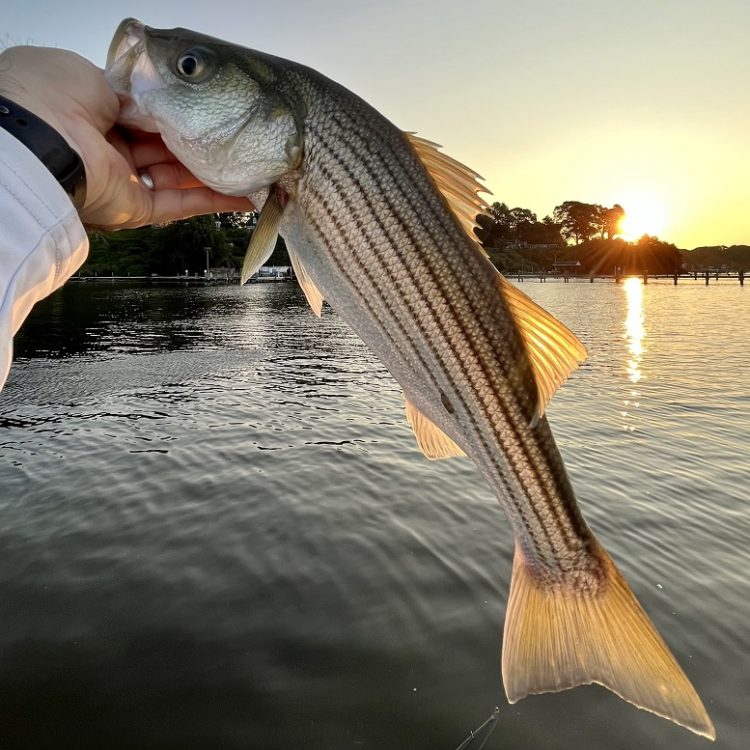
Last Friday morning, the pattern was easy. I targeted a flat that I’ve grown fond of, located between stretches of docks on either side. The flat has an average depth of about 4 feet. Near shoreline, a vast stretch of SAV covers bottom and the weedline is easily visible. Then there’s open water extending toward the ends of the docks and the river’s main stem for about 30 yards before the depth hits a sharp drop to about 17 to 20 feet. Position the boat just inside the dropoff and make casts throughout the 30-yard open stretch in this shallower water. Striped bass will move up from the deeper water at dawn and push baitfish between the dropoff and weedline—basically squeezing them into a feeding zone where topwater poppers and spooks will draw aggressive strikes. The magic hour is about 15 minutes before sunrise and lasts until the sun is three or four fingers above the horizon. By 7 a.m., I switched to a chartreuse jighead with “ice” colored paddletail, swimming it through the same zone to pick up a few more fish. Average size of fish was 20 inches. This is a classic mid-summer striper topwater pattern that anglers have repeatedly used this past month in many of the mid-bay rivers, and most especially in the Patapsco, Eastern Bay, Severn, lower South, and Choptank.
A better white perch bite—better than in the main bay that is—also remains in the rivers. Those that have tried very hard at traditionally hot white perch spots in the main bay, including at the eastern BB pilings and several reefs have had close-to-zero luck. A slew of miserable reports posted this week as such (but one has to wonder!). Stay in the rivers and find structure and shade. Find that combo now, even in shallower depths, and you should pull fish. Use microplastics on lighter jigheads, small spinnerbaits, beetlespins, or bait a bottom rig with grass shrimp. For the more trying angler, fly casting small, bright woollybuggers or light clousers can do the trick.
Back to those jig/paddletail lures you might be using for striped bass. They’re catching puppy drum as far up as the Severn River right now. Several anglers continue to show off catches that are barely slot size. Very cool. These lures are also catching cutlass fish in the middle bay right now. Anglers Eddie Weber and David Rudow hooked into a mess of them this week on brightly colored combos as such. Way to go guys! In the lower Choptank creeks near the mouth, you also have a shot at speckled trout by pitching these lures across shallow water in the morning, or deeper structure come high sun. The Little Choptank is also active. Ditto for the Solomons/Potomac region, where well-regarded and known angler, Eric Packard, continues to catch a mix of rocks, reds, and specks…often coming on the same style lure.
Main bay trollers are targeting stripers, but most especially bluefish and Spanish macks right now between the Bay Bridge and the lower 80 buoys, with #1 or 2 planers and Drone- or Clark-style spoons. It does appear most fish are still being caught south of Poplar Island.
Throughout the Potomac and Blackwater watersheds, the snake bite has been amazing. Fish the creeks for calmer water and dragon northern snakehead. And throw frogs, frogs, frogs. Any style of frog. Popping frogs…frogs with limbs, skirted legs, spinners. Bright frogs, dark frogs. Have a few on hand and give ‘em a try by sight casting beyond bubbling fry balls and retrieving through them. Mom or dad will likely strike with abandon. And if they don’t? Tie on a light, 4-inch fluke-style bait and twitch it through the ball. Don’t see fry? Pitch and retrieve around any and all cover.
Some great bass and sun fishing is being reported in the northern Tuckahoe vicinity, Marshyhope near Federalsburg, and the Pocomoke River. Large ribbon tail worms get the big bass to bite, while small jigs tipped with 2-inch Berkely Gulp minnows have been one angler’s choice for bucketfuls of bluegills, crappies, and perch nearly every…single…morning. Good luck!
View the full Reel Chesapeake Fishing Report, written and compiled by writer and media professional James Houck, at reelchesapeake.com.
Leave a Reply